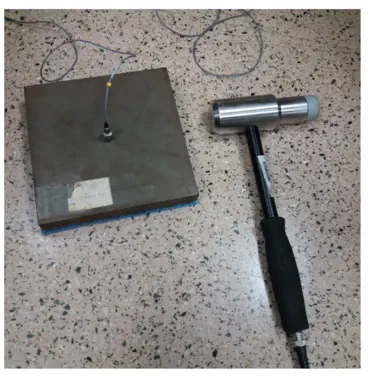Dynamic stiffness modelling
An efficient hierarchical modelling approach to determine the mechanical properties of a viscoelastic material using dynamic stiffness data using time-dependent models (ISO 9052-1:1989)
 Experimental setting to measure the dynamic stiffness of elastic materials used under floating floors
Experimental setting to measure the dynamic stiffness of elastic materials used under floating floorsThe standard ISO 9052-1 is used to determine the dynamic stiffness of elastic materials used under floating floors (see the experimental setting in the figure on top), which is one of the parameters used to determine the acoustic insulation of these floors. However, such value is not directly related to the elastic coefficients typically used in the Hooke's linear model, such as the Young modulus, the Poisson coeffcient, or the loss factor. Hence, an additional numerical or experimental procedure is required to determine from a quantitative point of view those material coefficients.
 Figure 1: Impulse response of the acceleration in an impact experiment.
Figure 1: Impulse response of the acceleration in an impact experiment.
In this project, a numerical methodology based on a hierarchical modeling approach is proposed, using only those experimental data obtained from the standard ISO 9052-1 framework (see a detailed discussion in Chapter 6 in [1]). Consequently, the purpose of this chapter is focused on the computation of some elastic coeffcients of viscoelastic and poroelastic materials by using a hierarchy of models. This project is part of a joint collaboration with Jesús Carbajo, Pedro Poveda, and Jaime Ramis from the Department of Physics, System Engineering and Signal Theory of the University of Alicante, and the available experimental data (see Figure 1) they have provided.
References
[1] Laura del Río MartínNumerical characterization of complex materials and vibro-acoustic systems
Phd thesis in mathematical modelling and numerical simulation in engineering and applied science,Universidade da Coruña, 2020. Advisor: A. Prieto.